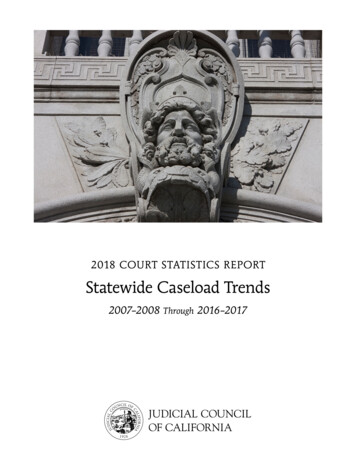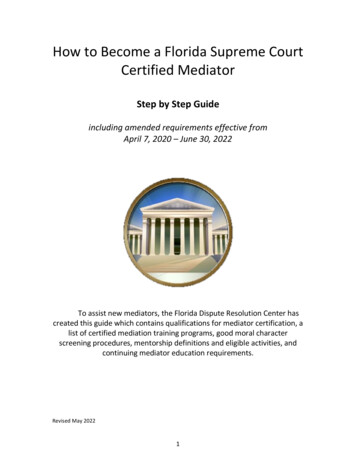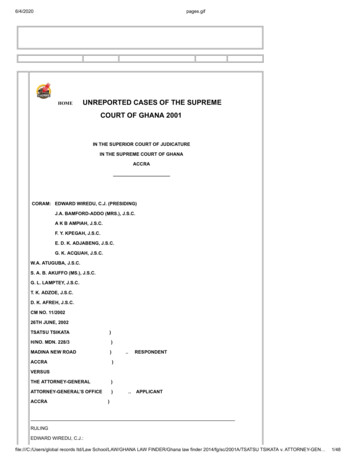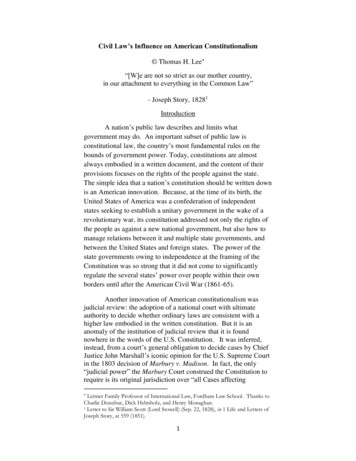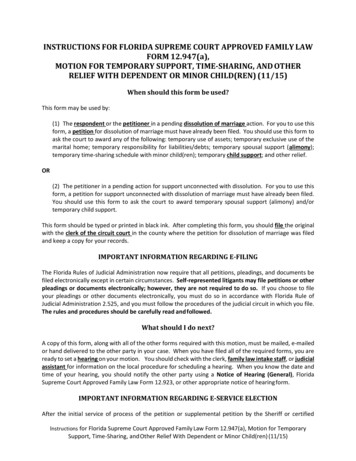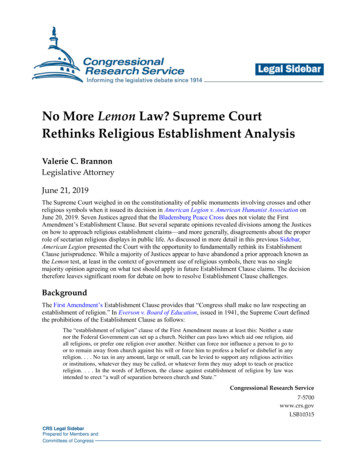
Transcription
No. 05-380In theSupreme Court of the United StatesALBERTO R. GONZALES, ATTORNEY GENERAL,Petitioner,v.LEROY CARHART , ET AL.,Respondents.On Writ of Certiorari to theUnited States Court of Appeals for the Eighth CircuitBRIEF OF THE STATES OF TEXAS, ALABAMA , ARKANSAS,FLORIDA , INDIANA , MISSOURI, NORTH DAKOTA , OHIO ,PENNSYLVANIA , SOUTH CAROLINA , SOUTH DAKOTA , UTAH ,AND VIRGINIA AS AMICI CURIAE IN SUPPORT OF PETITIONERGREG ABBOTTAttorney General of TexasR. TED CRUZSolicitor GeneralCounsel of RecordBARRY R. MCBEEFirst Assistant AttorneyGeneralJOEL L. THOLLANDERAssistant Solicitor GeneralEDWARD D. BURBACHDeputy Attorney Generalfor LitigationP.O. Box 12548Austin, Texas 78711-2548(512) 936-1700COUNSEL FOR AMICI CURIAE[Additional counsel listed on inside cover]
TROY KINGAttorney General of AlabamaMIKE BEEBEAttorney General of ArkansasCHARLES J. CRIST, JR.Attorney General of FloridaSTEVE CARTERAttorney General of IndianaJEREMIAH W. (JAY) NIXONAttorney General of MissouriWAYNE STENEHJEMAttorney General of North DakotaJIM PETROAttorney General of OhioTHOMAS W. CORBETT, JR.Attorney General of PennsylvaniaHENRY McMASTERAttorney General of South CarolinaLAWRENCE E. LONGAttorney General of South DakotaMARK L. SHURTLEFFAttorney General of UtahROBERT F. McDONNELLAttorney General of Virginia
iiQUESTION PRESENTEDWhether, notwithstanding Congress’s determination that a healthexception was unnecessary to preserve the health of the mother, thePartial-Birth Abortion Ban Act of 2003 is invalid because it lacksa health exception or is otherwise unconstitutional on its face.
iiiTABLE OF CONTENTSQuestion Presented . . . . . . . . . . . . . . . . . . . . . . . . . . . . . . . . . . . iiTable of Contents . . . . . . . . . . . . . . . . . . . . . . . . . . . . . . . . . . . iiiIndex of Authorities . . . . . . . . . . . . . . . . . . . . . . . . . . . . . . . . . viInterest of Amici Curiae . . . . . . . . . . . . . . . . . . . . . . . . . . . . . . . 1Summary of the Argument . . . . . . . . . . . . . . . . . . . . . . . . . . . . . 3Argument . . . . . . . . . . . . . . . . . . . . . . . . . . . . . . . . . . . . . . . . . . 6I.Stenberg v. Carhart Was Incorrectly Decided andShould Be Overruled . . . . . . . . . . . . . . . . . . . . . . . . . 6A.B.Stenberg Undervalued the State InterestsAdvanced byBans onPartial-BirthAbortion . . . . . . . . . . . . . . . . . . . . . . . . . . . . . . 61.Partial-birth abortion bans advanceimportant state interests . . . . . . . . . . . . . . 72.Stenberg acknowledged, but gave noweight to, these important stateinterests . . . . . . . . . . . . . . . . . . . . . . . . . 10Stenberg’s Health-Exception AnalysisDisregarded Casey’s Undue-Burden Standardand the Rule That Legislatures Are Free toAct in the Face of Medical Uncertainty . . . . . 11
ivC.II.1.Stenberg disregard Casey’s undueburden standard . . . . . . . . . . . . . . . . . . . 112.Stenberg disregarded the traditionalrule that legislatures are free to act inthe face of medical uncertainty . . . . . . . 13Stenberg Erred in Rejecting a PlausibleConstruction of the State Statute That MightHave Saved it From Invalidation . . . . . . . . . . 14Facial Challenges To Statutes Regulating AbortionRelated Conduct Should Be Subject To the “No Setof Circumstances” Test . . . . . . . . . . . . . . . . . . . . . . 18A.The Salerno Rule Has Long Been a Fixtureof the Court’s Jurisprudence . . . . . . . . . . . . . . 19B.The Salerno Rule is Compatible With theCourt’s Abortion Jurisprudence . . . . . . . . . . . 21C.The Court Has Twice Applied the SalernoRule in Facial Challenges to AbortionRelated Regulations . . . . . . . . . . . . . . . . . . . . 23D.The Salerno Rule Safeguards the ProperRelationship Between State Legislatures andthe Federal Courts . . . . . . . . . . . . . . . . . . . . . . 24E.The Court Has Properly Limited“Overbreadth” Analysis to Speech-RelatedClaims Under the First Amendment . . . . . . . . 27
vIII.The Federal Partial-Birth Abortion Ban Should BeUpheld Against This Facial Challenge . . . . . . . . . . 29Conclusion . . . . . . . . . . . . . . . . . . . . . . . . . . . . . . . . . . . . . . . . 29
viINDEX OF AUTHORITIESCasesA Choice for Women v. Butterworth, No. 00-182-0CIV,2000 WL 34403086 (S.D. Fla. July 11, 2000) . . 16, 17, 18A Woman’s Choice—East Side Women’s Clinic v. Newman,305 F.3d 684 (CA7 2002) . . . . . . . . . . . . . . . . . . . . . . 18, 21Anderson v. Edwards, 514 U.S. 143 (1995) . . . . . . . . . . . . . . 20Ayotte v. Planned Parenthood of N. New England,126 S.Ct. 961 (2006) . . . . . . . . . . . . . . . . . . . . . . . . . 19, 22Barnes v. Moore, 970 F.2d 12 (CA5),cert. denied, 506 U.S. 1021 (1992) . . . . . . . . . . . . . . . . . 21Broadrick v. Oklahoma, 413 U.S. 601 (1973) . . . . . 4, 19, 26-28Carhart v. Gonzales,413 F.3d 791 (CA8 2005) . . . . . . . . . . . . . . . . . 6, 18, 21, 22City of Chicago v. Morales, 527 U.S. 41 (1999) . . . . . . . . . . . 20Collins v. Texas, 223 U.S. 288 (1912) . . . . . . . . . . . . . . . . . 3, 13Edward J. DeBartolo Corp. v. Florida Gulf Coast Bldg.& Const. Trades Council, 485 U.S. 568 (1988) . . . . . . 4, 17Erznoznik v. Jacksonville,422 U.S. 205 (1975) . . . . . . . . . . . . . . . . . . . . . . . 17, 26, 27Frisby v. Schultz, 487 U.S. 474 (1988) . . . . . . . . . . . . . . . . . . 17
viiGreenville Women’s Clinic v. Bryant,222 F.3d 157 (CA4 2000) . . . . . . . . . . . . . . . . . . . . . . . . . 26Jacobson v. Massachusetts, 197 U.S. 11 (1905) . . . . . . . . . . . 14Jane L. v. Bangerter,102 F.3d 1112 (CA10 1996) . . . . . . . . . . . . . . . . . . . . . . . 21Kansas v. Hendricks, 521 U.S. 346 (1997) . . . . . . . . . . . . 13, 17Lambert v. Yellowley, 272 U.S. 581 (1926) . . . . . . . . . . . . . . . 14Liverpool, N.Y. & Philadelphia S.S. Co. v. Comm’rs ofEmigration, 113 U.S. 33 (1885) . . . . . . . . . . . . . . . . . . . . 25Manning v. Hunt, 119 F.3d 254 (CA4 1997) . . . . . . . . . . . 21, 23Marshall v. United States,414 U.S. 417 (1974) . . . . . . . . . . . . . . . . . . . . . . . . . . . . . 13Members of the City Council of Los Angeles v.Taxpayers for Vincent, 466 U.S. 789 (1984) . . . . . . . . . . 19N.Y. State Club Ass’n v. City of New York,487 U.S. 1 (1988) . . . . . . . . . . . . . . . . . . . . . . . . . . . . . . . 20Nat’l Abortion Fed’n v. Gonzales,437 F.3d 278 (CA2 2006) . . . . . . . . . . . . . . . . . . . 10, 11, 14New York v. Ferber, 458 U.S. 747 (1982) . . . . . . . . 5, 19, 25-28Ohio v. Akron Ctr. for Reprod. Health,497 U.S. 502 (1990) . . . . . . . . . . . . . . . . . . . . . 5, 20, 23, 24
viiiPalko v. Connecticut, 302 U.S. 319 (1937) . . . . . . . . . . . . . . . 28Planned Parenthood Fed’n of America v. Ashcroft,320 F.Supp.2d 957 (N.D. Cal. 2004) . . . . . . . . . . . . . . . . 16Planned Parenthood Fed’n of America v. Gonzales,435 F.3d 1163 (CA9 2006) . . . . . . . . . . . . . . . . . . . . . . . . 12Planned Parenthood of Cent. N.J. v. Farmer,220 F.3d 127 (CA3 2000) . . . . . . . . . . . . . . . . . . . . . . . . . 21Planned Parenthood of N. New Englandv. Heed, 390 F.3d 53 (CA1 2004), rev’d on othergrounds sub. nom. Ayotte v. Planned Parenthoodof N. New England, 126 S.Ct. 961 (2006) . . . . . . . . . . . . 21Planned Parenthood of S. Arizona v. Lawall,180 F.3d 1022 (CA9 1999) . . . . . . . . . . . . . . . . . . . . . . . . 21Planned Parenthood of Southeastern Pa. v. Casey,505 U.S. 833 (1992) . . . . . . . . . . . . . . . . . . . . . . . . . passimPlanned Parenthood, Sioux Falls Clinic v. Miller,63 F.3d 1452 (CA8 1995) . . . . . . . . . . . . . . . . . . . . . . . . . 21Reno v. Flores, 507 U.S. 292 (1993) . . . . . . . . . . . . . . . . . . . . 20Reprod. Health Servs. of Planned Parenthood v. Nixon,325 F.Supp.2d 991 (W.D. Mo. 2004),aff’d, 429 F.3d 803 (CA8 2005) . . . . . . . . . . . . . . . . . . . . 16Richmond Med. Ctr. for Women v. Hicks,301 F.Supp.2d 499 (E.D.Va. 2004),aff’d, 409 F.3d 619 (CA4 2005) . . . . . . . . . . . . . . 16, 17, 18
ixRoe v. Wade, 410 U.S. 113 (1973) . . . . . . . . . . . . . . . . . . 6, 7, 28Rust v. Sullivan, 500 U.S. 173 (1991) . . . . . . . . . . . 5, 20, 23, 24Schall v. Martin, 467 U.S. 253 (1984) . . . . . . . . . . . . . . . . . . . 28Sec’y of State of Maryland v. Munson Co.,467 U.S. 947 (1984) . . . . . . . . . . . . . . . . . . . . . . . . . . 19, 26Steffel v. Thompson,415 U.S. 452 (1974) . . . . . . . . . . . . . . . . . . . . . . . . . . . . . 19Stenberg v. Carhart, 530 U.S. 914 (2000) . . . . . . . . . . . . passimUnited States v. Raines, 362 U.S. 17 (1960) . . . . . . . . . . . 24, 27United States v. Salerno,481 U.S. 739 (1987) . . . . . . . . . . . . . . 2, 4, 5, 18, 19, 27-29Vill. of Hoffman Estates v. Flipside, Hoffman Estates, Inc.,455 U.S. 489 (1982) . . . . . . . . . . . . . . . . . . . . . . . . . . . . . 19Washington v. Glucksberg, 521 U.S. 702 (1997) . . . . . . . . . . . . 8Watson v. Buck, 313 U.S. 387 (1941) . . . . . . . . . . . . . . . . . . . 20Webster v. Reprod. Health Servs.,492 U.S. 490 (1989) . . . . . . . . . . . . . . . . . . . . . . . . . . 20, 22Women’s Med. Prof’l Corp. v. Taft,353 F.3d 436 (CA6 2003) . . . . . . . . . . . . . . . . . . . . . . . . 16
xWomen’s Med’l Prof’l Corp. v. Voinovich,130 F.3d 187 (CA6 1997) . . . . . . . . . . . . . . . . . . . . . . . . . 21Younger v. Harris, 401 U.S. 37 (1971) . . . . . . . 5, 20, 25, 27, 28Constitutional Provisions, Statutes, and RulesU.S. CONST . amend. XIV, §1 . . . . . . . . . . . . . . . . . . . . . . . . . 7-8U.S. CONST . art. III, §2 . . . . . . . . . . . . . . . . . . . . . . . . . . . . 25, 26ALA . CODE §§26-23-1 to -6 . . . . . . . . . . . . . . . . . . . . . . . . . . . . 1ALASKA STAT . §18.16.050 . . . . . . . . . . . . . . . . . . . . . . . . . . . . . 1ARIZ. REV . STAT . §13-3603.01 . . . . . . . . . . . . . . . . . . . . . . . . . 1ARK. CODE ANN . §§5-61-202, -203 . . . . . . . . . . . . . . . . . . . . . . 1FLA . STAT . ANN . §782.32 . . . . . . . . . . . . . . . . . . . . . . . . . . . . 15FLA . STAT . ANN . §§390.011, 782.32 – .36 . . . . . . . . . . . . . . . . 1GA . CODE ANN . §16-12-144 . . . . . . . . . . . . . . . . . . . . . . . . . . . 1IDAHO CODE ANN . §18-613 . . . . . . . . . . . . . . . . . . . . . . . . . . . . 1720 ILL. COMP. STAT . 513/10 . . . . . . . . . . . . . . . . . . . . . . . . . . . 1IND . CODE ANN . §§16-34-2-1, 16-18-2-267.5 . . . . . . . . . . . . . . 1IOWA CODE ANN . §707.8A . . . . . . . . . . . . . . . . . . . . . . . . . . . . 1KAN . STAT . ANN . §65-6721 . . . . . . . . . . . . . . . . . . . . . . . . . . . . 1
xiKY . REV . STAT . ANN . §§311.720, .765 . . . . . . . . . . . . . . . . . . . 1LA . REV . STAT . ANN . §14:32.9 . . . . . . . . . . . . . . . . . . . . . . . . . 1MICH . COMP. LAWS ANN . §333.1081-.1085 . . . . . . . . . . . . . . . 1MICH . COMP. LAWS ANN . §333.1082(c) . . . . . . . . . . . . . . . . . . 8MICH . COMP. LAWS ANN . §333.17016 . . . . . . . . . . . . . . . . . . . . 1MISS. CODE ANN . §41-41-73 . . . . . . . . . . . . . . . . . . . . . . . . . . . 1MO . REV . STAT . §565.300 . . . . . . . . . . . . . . . . . . . . . 1, 8, 15-16MONT . CODE ANN . §50-20-102(2)(e) . . . . . . . . . . . . . . . . . . . . 9MONT . CODE ANN . §§50-20-102, -401 . . . . . . . . . . . . . . . . . . . 1N.D. CENT . CODE §§14-02.6-01 to -03 . . . . . . . . . . . . . . . . 1, 16N.J. STAT . ANN . §2A:65A-6 . . . . . . . . . . . . . . . . . . . . . . . . . . . 1N.M. STAT . ANN . §§30-5A-1 to -5 . . . . . . . . . . . . . . . . . . . . . . 1NEB. REV . STAT . ANN . §28-328(1) . . . . . . . . . . . . . . . . . . . . . 14NEB. REV . STAT . §28-326(9) . . . . . . . . . . . . . . . . . . . . . . . . . . 15NEB. REV . STAT . §§28-326, -328 . . . . . . . . . . . . . . . . . . . . . . . . 12000 Ohio Laws H 351, §3 . . . . . . . . . . . . . . . . . . . . . . . . . . 8, 9OHIO REV . CODE ANN . §2919.151 . . . . . . . . . . . . . . . . 1, 8, 9, 16
xiiOKLA . STAT . tit. 21, §684 . . . . . . . . . . . . . . . . . . . . . . . . . . . . . 1Partial-Birth Abortion Ban Act of 2003,Pub. L. No. 108-105, §3, 117 Stat. 1201 . . . . . . . . . . 15, 24Partial-Birth Abortion Ban Act of 2003,Pub. L. No. 108-105, §2(14),117 Stat. 1204-1206 . . . . . . . . . . . . . . . . . . . . . . . . . 8, 9, 14R.I. GEN . LAWS §§23-4.12-1 to -6 . . . . . . . . . . . . . . . . . . . . . . . 1S.C. CODE ANN . §44-41-85 . . . . . . . . . . . . . . . . . . . . . . . . . . . . 1S.D. CODIFIED LAWS §34-23A-27 . . . . . . . . . . . . . . . . . . . . . . . 1TENN . CODE ANN . §39-15-209 . . . . . . . . . . . . . . . . . . . . . . . . . 1UTAH CODE ANN . §76-7-301 . . . . . . . . . . . . . . . . . . . . . . . . . . 16UTAH CODE ANN . §§76-7-301, -326 . . . . . . . . . . . . . . . . . . . . . 1VA . CODE ANN . §18.2-74.2 . . . . . . . . . . . . . . . . . . . . . . . . . 1, 16W.VA . CODE ANN . §§33-42-3, -8 . . . . . . . . . . . . . . . . . . . . . . . 1WIS. STAT . §940.16 . . . . . . . . . . . . . . . . . . . . . . . . . . . . . . . . . . 1Other AuthoritiesMichael C. Dorf, Facial Challenges to State andFederal Statutes, 46 STAN . L. REV . 235 (1994) . . . . . . . . 28
xiiiPartial-Birth Abortion Ban Act of 2003: Hearing Before theSubcomm. on the Constitution of the H. Comm.on the Judiciary, 108th Cong. 26 (2003) . . . . . . . . . . . . . 11
INTEREST OF AMICI CURIAEThe amici States, through their Attorneys General, respectfullysubmit this brief in support of Petitioner. Although this appealconcerns the constitutionality of the federal government’s ban onpartial-birth abortion, regulation of abortion-related conduct isprimarily a state activity, and there is widespread interest among theStates in banning partial-birth abortion. In the past decade, thirtyone States have passed legislation restricting partial-birth abortion.1Many of these state statutes were invalidated or renderedunenforceable by the Court’s decision in Stenberg v. Carhart, 530U.S. 914 (2000), which held that Nebraska’s partial-birth abortionban was unconstitutional on its face. The amici States believe thatStenberg misapplied the relevant substantive standard announcedin Planned Parenthood of Southeastern Pa. v. Casey, 505 U.S. 833(1992), undermining the Court’s commitment in Casey to anabortion jurisprudence that would respect and give appropriateweight to the vital state interests at play in this sensitive context, seeid., at 871.1. See ALA . CODE §§26-23-1 to -6; ALASKA STAT . §18.16.050; ARIZ .REV . STAT . §13-3603.01; ARK . CODE ANN . §§5-61-202, -203; FLA . STAT .ANN . §§390.011, 782.32 – .36; GA . CODE ANN . §16-12-144; IDAHO CODEANN . §18-613; 720 ILL . COM P . STAT . 513/10; IND . CODE ANN .§§16-34-2-1, 16-18-2-267.5; IOWA CODE ANN . §707.8A; KAN . STAT .ANN . §65-6721; KY . REV . STAT . ANN . §§311.720, .765; LA . REV . STAT .ANN . §14:32.9; MICH . COM P . LAW S ANN . §§333.1081-.1085, .17016;MISS . CODE ANN . §41-41-73; MO . REV . STAT . §565.300; MONT . CODEANN . §§50-20-102, -401; NEB . REV . STAT . §§28-326, -328; N.J. STAT .ANN . §2A:65A-6; N.M. STAT . ANN . §§30-5A-1 to -5; N.D. CENT . CODE§§14-02.6-01 to -03; OHIO REV . CODE ANN . §2919.151; OKLA . STAT . tit.21, §684; R.I. GEN . LAW S §§23-4.12-1 to -6; S.C. CODE ANN . §44-41-85;S.D. CODIFIED LAW S §34-23A-27; TENN . CODE ANN . §39-15-209; UTAHCODE ANN . §§76-7-301, -326; VA . CODE ANN . §18.2-74.2; W.VA . CODEANN . §§33-42-3, -8; WIS . STAT . §940.16.
2The amici States urge the Court to recognize the governmentalinterests implicated by partial-birth abortion, and to reaffirm itscommitment to an abortion jurisprudence that accords to thesecritical interests the weight they are due.The amici States are also interested in the Court’s resolution ofthe appropriate standard for federal-court review of facialchallenges to abortion-related regulations. The traditional rule,definitively articulated by the Court in United States v. Salerno, 481U.S. 739, 745 (1987), is that those who seek to prevent a statutefrom being applied in any and all circumstances must show that thestatute in fact cannot be validly applied in any and allcircumstances.The amici States have a strong interest in ensuring that theirstate statutes are treated uniformly by federal courts that areentertaining facial challenges, and believe that the Salerno rule isappropriate for all such challenges, including challenges to statutesregulating abortion-related conduct. In resolving this appeal, thisCourt should reject the court of appeals’s conclusion to thecontrary.
3SUMMARY OF THE ARGUMENTThe amici States urge the Court to overrule Stenberg v.Carhart. In the considered judgment of the amici States, theCourt’s analysis in Stenberg suffered from three critical errors:First, the Stenberg decision failed to give appropriate weightto the multiple state interests advanced by bans on partial-birthabortion. Such bans promote at least four important governmentalinterests: they draw a bright line distinguishing abortion frominfanticide; they help to preserve the integrity of the medicalprofession; they encourage respect for human life; and they preventunnecessary cruelty to the aborted fetus. Stenberg recognized mostof these interests, but held that they could not “make anydifference” to the constitutional calculus if partial-birth abortionmight sometimes be marginally safer for the mother than thealternative methods of late-term abortion. 530 U.S., at 931-32.This constitutional elevation of one factor above every otherimplicated state interest was error. See Casey, 505 U.S., at 871-73.Second, Stenberg’s health-exception analysis disregarded therelevant undue-burden standard as well as the traditional rule thatlegislatures are free to act in the face of medical uncertainty. Ratherthan asking whether the ban’s lack of a maternal-health exceptionplaced an undue burden on a woman’s decision to terminate herpregnancy, see Casey, 505 U.S., at 877, Stenberg asked whetherthere was a consensus that partial-birth abortion would never be thesafest late-term abortion procedure, 530 U.S., at 932. Thistreatment of consensus in the medical community as a dispostiveconstitutional factor was in sharp conflict with the Court’slongstanding assumption that legislatures have authority to makedifficult policy choices “even upon medical matters concerningwhich there is a difference of opinion and dispute.” Collins v.Texas, 223 U.S. 288, 297-98 (1912).
4Third, Stenberg erred in rejecting a plausible construction ofthe state ban that might have saved it from invalidation.Notwithstanding that the statute purported to reach only partialbirth abortion and that the State’s Attorney General insisted that thestate courts would read the ban to reach only partial-birth abortion,the Court in Stenberg invalidated the ban on the ground that it couldtheoretically be read to reach another method of late-term abortion,“and future Attorneys General may choose” to read it in thatmanner. 530 U.S., at 945. That conclusion was in conflict with arule of statutory construction that “has for so long been applied bythis Court that it is beyond debate”—that is, “where an otherwiseacceptable construction of a statute would raise seriousconstitutional problems, the Court will construe the statute to avoidsuch problems.” Edward J. DeBartolo Corp. v. Florida Gulf CoastBldg. & Const. Trades Council, 485 U.S. 568, 575 (1988).There is a second issue of great significance to the amici Statessquarely raised by this appeal: the appropriate standard for federalcourt review of facial challenges to abortion-related regulation. Theamici States urge the Court to reaffirm that, in the abortion contextas elsewhere, those who seek to prevent a properly-enacted statutefrom being applied in any and all circumstances should be requiredto show that it cannot be validly applied in any and allcircumstances. That is the rule of Salerno, 481 U.S., at 745, and itis a sound one.Although the rule received its definitive articulation in Salerno,it is grounded in constitutional and prudential limitations on thepower of federal courts that have been recognized and respected bydecisions of the Court as far back as Marbury v. Madison. Federalcourts are not “roving commissions assigned to pass judgment onthe validity of the Nation’s laws,” Broadrick v. Oklahoma, 413 U.S.601, 610-11 (1973); they are instead tasked with “resolvingconcrete disputes brought before the courts for decision,” and mustdecline to apply a statute “when such an application of the statute
5would conflict with the Constitution.” Younger v. Harris, 401 U.S.37, 52 (1971). Only when every application would conflict with theConstitution, therefore, should federal courts find a statute whollyinvalid.In addition to these institutional limitations on federal courtpower, principles of federalism counsel further restraint whenfederal courts are asked to review the constitutionality of lawsenacted by a state legislature. In such cases, application of theSalerno rule discouraging facial invalidation creates salutaryopportunities for state courts “to construe a law to avoidconstitutional infirmities.” New York v. Ferber, 458 U.S. 747, 768(1982).There is no good reason not to apply the Salerno rule to facialchallenges to legislation regulating abortion-related conduct.Indeed, the Court has explicitly chosen to apply the rule to suchchallenges on more than one occasion. See Rust v. Sullivan, 500U.S. 173, 183 (1991); Ohio v. Akron Ctr. for Reprod. Health, 497U.S. 502, 514 (1990) (“Akron II”). It should do so again here.The court of appeals’s failure to apply the Salerno rule to thisfacial challenge to the federal partial-birth abortion ban resulted inan unjustified invalidation of the act, in its entirety, “based upon aworst-case analysis that may never occur.” Akron II, 497 U.S., at514. Under Salerno and Casey, the proper question for the court ofappeals was whether Respondents had demonstrated that the federalpartial-birth abortion ban, in each and every of its potentialapplications, poses a substantial obstacle to a woman seeking toabort her late-term, but still nonviable, fetus. Salerno, 481 U.S., at745; Casey, 505 U.S., at 877. Had the court of appeals asked thatquestion, the correct result in this case would have been clear: thefederal partial-birth abortion ban should be upheld.
6ARGUMENTI.STENBERG V. CARHART WAS INCORRECTLY DECIDED ANDSHOULD BE OVERRULED .The court of appeals held that the fate of the federal ban onpartial-birth abortion was sealed by the Court’s decision in Stenbergv. Carhart, 530 U.S. 914 (2000), which struck down Nebraska’spartial-birth abortion ban on the grounds that it lacked a healthexception and that it might be read to reach another, more commonmethod of late-term abortion. Id., at 937-38, 945-46; see alsoCarhart v. Gonzales, 413 F.3d 791, 796 (CA8 2005). The UnitedStates advances sound reasons why, given the extensivecongressional findings, inter alia, the federal Partial-Birth AbortionBan Act should survive Stenberg. But those federal distinctionsprovide little solace to States seeking to pass their own legislationprohibiting the practice of partial-birth abortion. Rather thansimply distinguishing Stenberg, the Court should take the directroute: because Stenberg undervalued the important state interestsadvanced by banning partial-birth abortion, disregarded the undueburden standard in its health-exception analysis, and rejected aplausible construction of the state ban that might have saved it frominvalidation, the amici States urge the Court to recognize thatStenberg was wrongly decided, and, accordingly, to overrule it.A.Stenberg Undervalued the State Interests Advancedby Bans on Partial-Birth Abortion.In Planned Parenthood of Southeastern Pa. v. Casey, 505 U.S.833 (1992), the Court reaffirmed the central holding of Roe v.Wade, 410 U.S. 113 (1973), that the Due Process Clause extends tocover a woman’s choice to have an abortion before the fetus isviable. But the Court in Casey expressly rejected Roe’s trimesterframework and the strict scrutiny that had previously been appliedto abortion-related regulations as undervaluing the important and
7legitimate state interests at play in the abortion context. Casey, 505U.S., at 871-73.Casey recognized that although Roe had spoken “with clarity”of the States’ “important and legitimate interest in potential life,”that particular “portion of the decision in Roe [had] been given toolittle acknowledgment and implementation by the Court in itssubsequent cases.” Casey, 505 U.S., at 871; see also Roe, 410 U.S.,at 163. Thus, the new standard announced in Casey was intendedto ensure that these interests would be accorded sufficient respectand weight going forward, and that the States would be “free toenact laws to provide a reasonable framework for a woman to makea decision that has such profound and lasting meaning.” Casey, 505U.S., at 873. Under Casey’s new standard, “[o]nly where stateregulation imposes an undue burden on a woman’s ability” tochoose an abortion would the statute be considered to infringe “theliberty protected by the Due Process Clause.” Id., at 874.Though Casey promised an abortion jurisprudence in whichimportant state interests would be given the respect they are due,Stenberg failed to make good on that promise, and failed to accordany real weight to the public interests justifying partial-birthabortion bans—interests recognized as legitimate, even compelling,by a majority of state legislatures as well as our national Congress.1. Partial-birth abortion bans advance important stateinterests.Partial-birth abortion bans advance at least four important stateinterests: they draw a bright line that clearly distinguishes betweenabortion and infanticide; they help to preserve the integrity of themedical profession; they promote respect for human life; and theyprevent unnecessary cruelty to the aborted fetus.Once completely outside the mother’s body, a child is a legalperson entitled to full constitutional protection. U.S. CONST .
8amend. XIV, §1. Prohibitions on partial-birth abortion are designedto prevent the unnecessary death of those substantially outside themother’s body, “mere inches away” from becoming a constitutionalperson. Partial-Birth Abortion Ban Act of 2003 (“PBABA”), Pub.L. No. 108-105, §2(14)(H), 117 Stat. 1205; see also OHIO REV .CODE ANN . §2919.151; 2000 Ohio Laws H 351, §3(A). Such lawsrecognize partial-birth abortion’s “resemblance to infanticide,”Stenberg, 530 U.S., at 963 (Kennedy, J., dissenting), and advancea critical interest in “maintaining a strong public policy againstinfanticide, regardless of the life expectancy or stage ofdevelopment of the child,” 2000 Ohio Laws H 351, §3(B); see alsoMICH . COMP. LAWS ANN . §333.1082(c); MO . REV . STAT .§565.300(3). This interest in drawing a bright line betweenabortion and infanticide is directly analogous to the state interest theCourt relied upon in Washington v. Glucksberg, 521 U.S. 702(1997), as justifying a state ban on assisted suicide. See id., at 732(recognizing as legitimate the State’s “fear that permitting assistedsuicide will start it down the path to voluntary and perhaps eveninvoluntary euthanasia”).The Court in Glucksberg also recognized that States have an“interest in protecting the integrity and ethics of the medicalprofession.” Id., at 731; see also Stenberg, 530 U.S., at 962(Kennedy, J., dissenting) (“A State may take measures to ensure themedical profession and its members are viewed as healers,sustained by a compassionate and rigorous ethic and cognizant ofthe dignity and value of human life, even life which cannot survivewithout the assistance of others.”). Bans on partial-birth abortionadvance this important interest because, as Congress has found,partial-birth abortion “undermines the public’s perception of theappropriate role of a physician during the delivery process, andperverts a process during which life is brought into the world, inorder to destroy a partially-born child.” PBABA, §2(14)(K), 117Stat. 1205; see also Stenberg, 530 U.S., at 963 (Kennedy, J.,
9dissenting) (noting that state legislatures might rationally concludethat partial-birth abortion “presents a greater risk of disrespect forlife and a consequent greater risk to the [medical] profession andsociety, which depend for their sustenance upon reciprocalrecognition of dignity and respect”).Partial-birth abortion bans also promote a respect for life. Theamici States agree with Congress that the partial-birth abortionprocedure reflects a “disregard for infant human life,” andpermitting its practice threatens to “further coarsen society to thehumanity of not only newborns, but all vulnerable and innocenthuman life, making it increasingly difficult to protect such life.”PBABA, §2(14)(L), (N), 117 Stat. 1206; see also MONT . CODEANN . §50-20-102(2)(e) (“the state has a duty to protect innocent lifeand that duty has grown to a compelling point with respect topartial-birth abortion”); Stenberg, 530 U.S., at 961 (Kennedy, J.,dissenting) (“States also have an interest in forbidding medicalprocedures which, in the State’s reasonable determination, mightcause . . . society as a whole to become insensitive, even disdainful,to life, including life in the human fetus.”).Bans on partial-birth abortion may also further a state interest inpreventing unnecessary cruelty to the aborted late-term fetus. Asthe State of Ohio has determined, this interest is based in part on theability of a late-term fetus to experience pain, but does not restsolely on that ground: “[t]he indignity of being partly deliveredbefore being deliberately killed is also a form of cruelty that shouldnot be unnecessarily inflicted upon any being of human origin.Therefore, there are legitimate reasons for deterring the unnecessaryuse of the partial birth procedure, even though other abortionprocedures that may cause pain remain available.” 2000 Ohio LawsH 351, §3(D); OHIO REV . CODE ANN . §2919.151; see also, e.g.,PBABA, §2(14)(M), 117 Stat. 1206 (finding tha
No. 05-380 In the Supreme Court of the United States A LBER TO R. G ONZAL ES, A TTORN EY G EN ER AL, Petitioner, v. L ER OY C A RHA RT, ET AL., Re sp on de nts . On Writ of Certiorari to the United States Court of Appeals for the Eighth Circuit B RIEF OF THE S TATES OF T EXAS, A L A B A MA, A RKANS AS,


